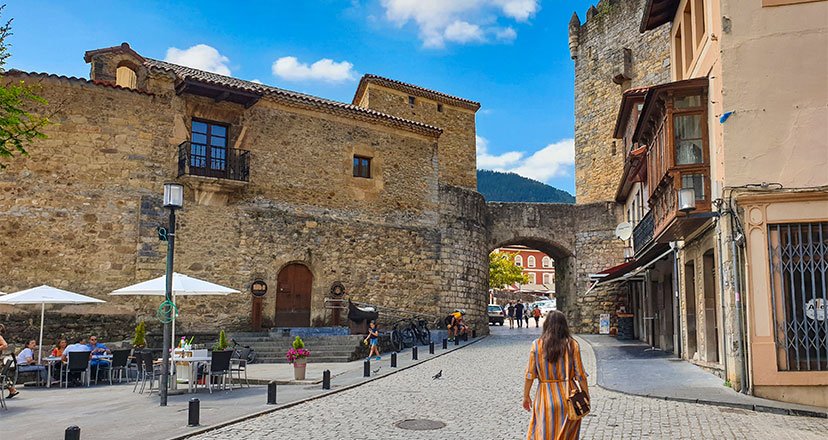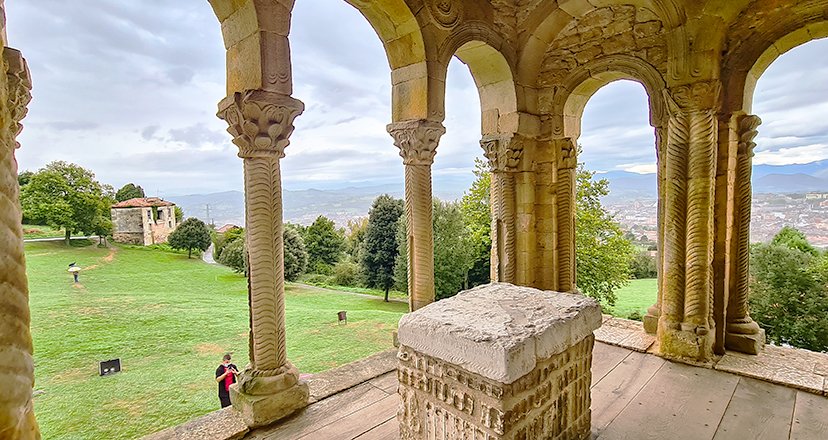Back 7 finds on the Primitive Way in Asturias
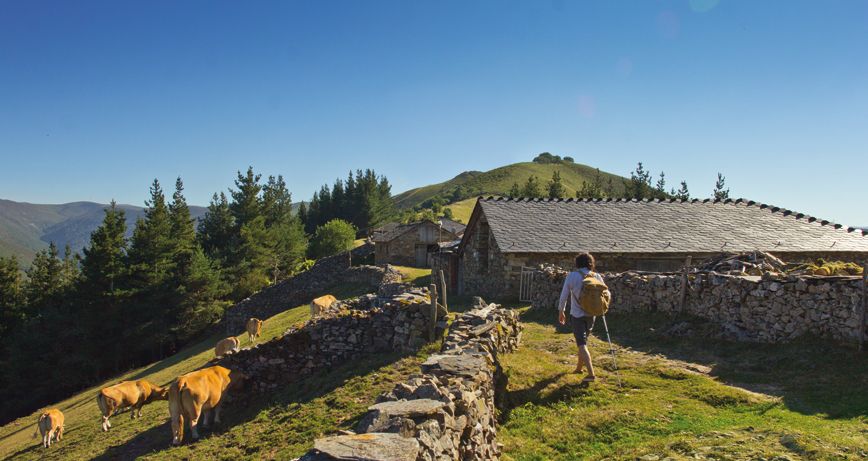
The best finds on the Primitive Way in Asturias
The passage along the Primitive Way has obvious wonders in store. They are jewels that deserve to be taken into account by walkers on their Jacobean adventure. Here are 7 that will leave you impressed.
The passage along the Primitive Way has obvious wonders in store. They are right there, at the foot of the route, and it would be exceptional not to notice them. The main one is the beautiful landscape that stretches from the exit of Oviedo/Uviéu until the route leaves Asturias through the Alto del Acebo, past the village of Grandas de Salime.

To this we must add the buildings that we have already listed in a previous entry - thepalace of the Miranda-Valdecarzana family and the Chapel of Dolores (Grau/Grado), the monastery of San Salvador de Cornellana and the collegiate church of Santa María la Mayor (Salas), the monastery of Santa María la Real de Obona (Tineo), the palace of the Cienfuegos de Peñalba (Allande) or the Chao Samartín (Grandas de Salime)- and which constitute exceptional examples of a historical and artistic heritage that has been able to withstand the course of the centuries on the Pilgrim's Way to Santiago de Compostela. However, there are other jewels that, because they are somewhat off the official itinerary or belong to the realm of the intangible, may go unnoticed and also deserve to be taken into account by walkers willing to embark on the adventure. These are some of them:
Roman Baths of Santa Eulalia de Valduno (Las Regueras)
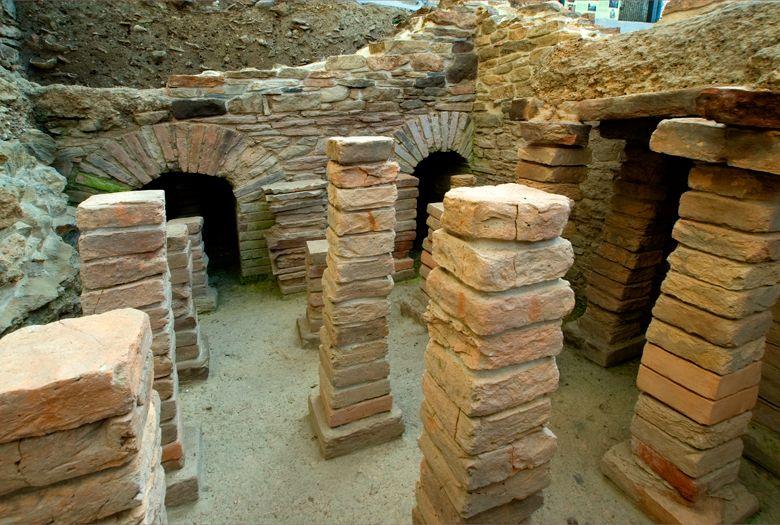
In the mid-19th century, Ciriaco Miguel Vigil reported the existence of Roman remains in the area of Valduno, in the municipality of Las Regueras, in his monumental, epigraphic and diplomatic Asturias. According to that text, next to the house of a farmer called Domingo Tamargo, there were some bricks and a hand mill made of grain stone which most probably dated from the time of Imperial rule. In 1947, a monumental tombstone dedicated to Sestio Munigalico was found there and is kept in the Archaeological Museum of Asturias, but this was not the only discovery. In 2006, work was carried out in the area around the parish church and the first tasting revealed, by chance, the existence of some thermal baths dating from between 60 and 130 AD. In them, it is possible to clearly appreciate the area of arches for the passage of heat and a semicircular bath with a continuous bench. Valduno is considered one of the best-preserved baths in northern Spain, and the archaeologist Rogelio Estrada, one of the leading experts on its details, believes that today only what is approximately a quarter of an entire Roman house can be seen. The baths are not on the route of the Camino, but the detour you have to take to get to them is minimal and is well signposted. It is a good excuse to take a break during the first stage of the route and appreciate this small wonder hidden in the heart of Asturias.
Carajitos del profesor (Salas)

It would be unforgivable to cross the council of Salas and not stop to try this sweet, one of the most paradigmatic of Asturias and a regular refreshment in the days when it was essential to pass through there if you were driving from the centre of the autonomous community in the direction of Galicia. The carajitos have so much tradition that this year marks the first centenary of the place where they were born. In 1918, Pepín el Profesor, music teacher and director of the local band, opened the Café del Profesor, a café-restaurant, in the village of Salas. Years later, his son Falín took over the business and, in the afternoons, and only for the regular customers, he began to make hazelnut pastries that tasted of glory soaked in the cold winter coffees. They were named after him by one of the customers, a returned Indian, who used to ask for them with the phrase: "Falín, give me one of those! The good Falín is no longer here, but the business that inherits his name is still open, and its owners continue to sell their famous carajitos, as well as traditional products and other sweets typical of Asturian gastronomy.
Church of San Martín (Salas)
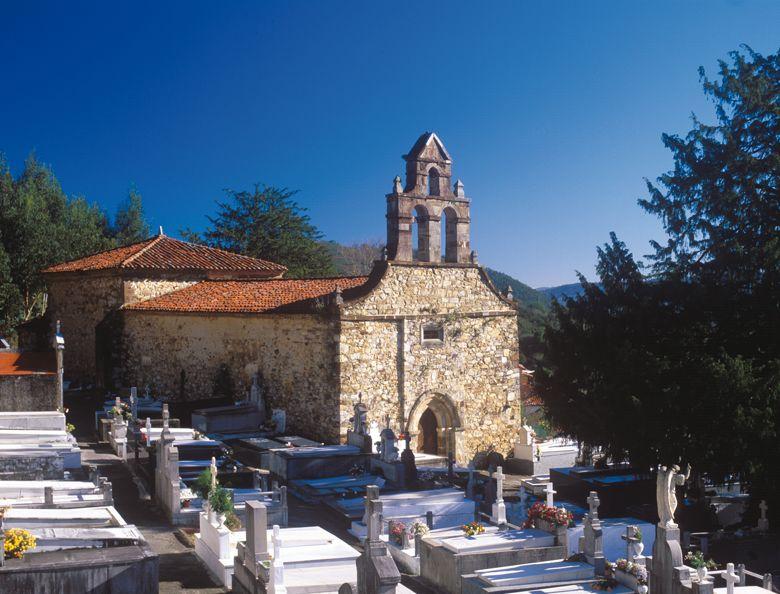
It is somewhat distant from the town, in the village of the same name, but it is worth a visit to get a full sense of the historical importance of the places that our steps lead us through. The church of San Martín de Salas is the only remaining vestige of the monastery that bore that name and which was built between the 8th and 9th centuries, that is to say, in the times of the Asturian Monarchy. Some remains of the old factory can be seen in the museum set up inside the Torre de los Valdés-Salas (Tower of the Valdés-Salas), in the centre of the town, opposite the collegiate church. The church in question stands in the shade of a thousand-year-old yew tree and was built in the 15th century, although it underwent major alterations in the 17th and 18th centuries. It is accessed through a Gothic-style doorway, and its single nave covered by a gabled roof houses a rectangular presbytery topped with a ribbed vault and a Rococo-style altarpiece. The decorative epigraphic motifs that came from the original church were removed and deposited in the Tower of Valdés-Salas, as mentioned above, but in their place faithful reproductions have been installed in the church, indicating how those remains of the early medieval construction were reused in the walls of the new building.
Balcón de Riego (Tineo)

The council of Tineo boasts of being the birthplace of Rafael del Riego, one of the most esteemed politicians of the 19th century in Spain. Born in the village of Tuña, into a noble family, he graduated in Law and Canons at the University of Oviedo/Uviéu and moved to Madrid to join the Guardia de Corps. When the War of Independence broke out in 1808, General Murat imprisoned him in the Escorial monastery, from where he managed to escape to return to Asturias, where his own father was a member of the Junta Suprema. However, he was arrested again in November of the same year and was deported to France. There he was initiated into liberal theories and came into contact with Freemasonry. After visiting England and Germany, he returned to Spain in 1814, rejoined the army with the rank of lieutenant colonel and took the oath of allegiance to the Constitution of 1812. When Ferdinand VII repealed it and began his absolutist drift, Rafael del Riego did not let up until he rebelled against his king. He succeeded on 1 January 1820, when in the Sevillian town of Cabezas de San Juan, he led the famous pronunciamiento that would put an end to the Bourbon-led Restoration and mark the beginning of what has come to be known in history books as the Liberal Triennium. It is said that in that same year, Riego returned to his homeland and gave an acclaimed speech in the town of Tinéu in which he conveyed the good news to his countrymen. The balcony from which he would have addressed the people still exists. It is located in a corner building in the Plaza Mayor square, opposite the Town Hall, and a plaque commemorates the event.
Palo reservoir and village of Montefurado (Allande)

The ascent to the Palo pass, in the council of Allande, is so arduous that it is possible that walkers, on reaching the summit, do not pay attention to what looks like a small pond where the livestock that are scattered around these parts tend to water. It is possible that, if they do, they do not attach any special importance to it either, because they understand that it is a natural hollow to which the abundant rainfall supplies water. In reality, the small lake dates back to Roman times and is the remains of the reservoir (palus) that the Romans installed there and which eventually gave its name to the port. There is another testimony - as interesting or even more, if possible - which states that the witches of the region celebrated around it, at some point in the 19th century, the last witches' coven of which there is documentary evidence in Asturias. El Palo is much more than a geographical feature: it is also a sentimental frontier. The people of Allandes differentiate between those who live "del Palo p'acá" - that is, towards La Pola - and those who live "del Palo p'allá", that is, towards Grandas de Salime. The former make up the group of the "curitos", probably because of the relationship of dependence that Pola de Allande maintained with the diocese of Oviedo, and the latter were and are included in the group of the "gal.legos", for obvious reasons.
About two kilometres from the summit, following the route of the Way, is the village of Montefurado, one of the most paradigmatic of the primitive itinerary. At the entrance to the village, where only one inhabitant lives, stands a chapel, normally closed, in which an image of the Apostle St. James is kept, much loved by pilgrims. The languor of the half-ruined buildings and the solitude that reigns in the environment make this a curious place, in keeping with its own place name, which recalls how the Romans dug galleries under these same mountains to look for gold veins. One of these cavities is still preserved here almost intact and the locals, when there were any, used to refer to it as the cave of Xuan Rata. The nickname was based on an old legend about a brave young man who, according to gossip, managed to kill the mythological being that lived in the bowels of the mountain.
The Salime reservoir: the devil and the bridge
But the most substantial legend of the entire Primitive Way is to be found a few kilometres to the west, at the Grandas de Salime reservoir. It is said that the devil himself came many years ago to do his thing in these lands and that, after a lot of jumping from cliff to cliff, he ended up stumbling and fell into the waters of the mighty river Navia. The current dragged him for a long time and the poor creature seriously feared for his life. He managed to grab hold of some branches and return to dry land, at which point, seized by a sincere joy, he began to utter cries that resounded throughout the valley: "Salime! Salime!" Some young men who were in the area, upon catching the demon himself jumping for joy, seized him and threw him back into the water. Once again the wretched Luzbel found himself struggling, and once again, on stepping in the mud on the shore, he gave vent to his joy with another exclamation: "Subalime! The legend, which is very amusing, has a toponymic explanation. Salime and Subsalime were two of the villages that were flooded when, between 1955 and 1957, the reservoir that the walkers see today was put into operation. The Salto de Salime has an impressive dam on which the architects Joaquín Vaquero Palacios and Joaquín Vaquero Turcios did much work, the latter being the author of a superb mural that decorates its interior, and around it are the ghostly ephemeral villages in which the workers who worked on its construction settled. It is worth listing, lest they be completely forgotten, the names of the small villages that disappeared forever when the valley was occupied by the waters of the river: Salcedo, San Feliz, Doade, Saborín, Riodeporco, A Quintana, Barqueiría, Veiga Grande, San Pedro de Ernes, Vilagudín and Barcela.
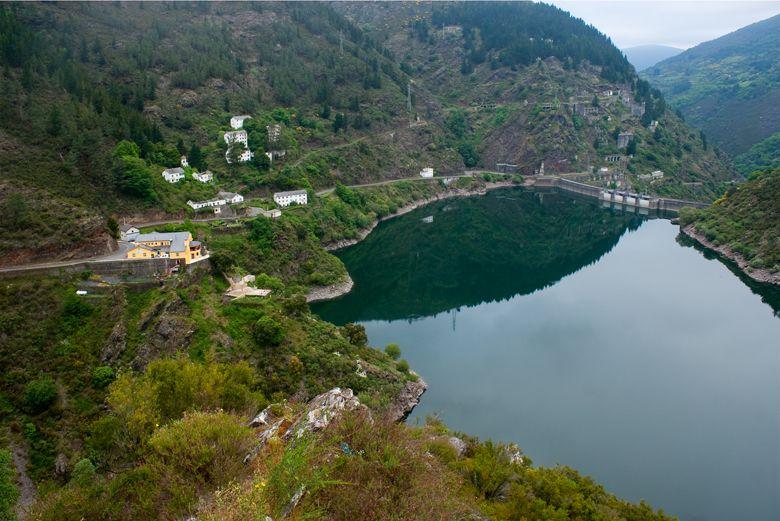
Another legend, although there are those who do not strictly speaking have it as such, refers to the village of Salime itself and to a bridge of which there is an old black and white photograph in volume III of the monumental Asturias, a work coordinated by Octavio Bellmunt and Fermín Canella between the 19th and 20th centuries. Jovellanos said of it that it was "on the prodigious height of the river". Popular lore has it that the following inscription could be read on its keystone -that is, in an almost implausible place-:
PEDRO DE PEDRE
DE CASTRO NATURAL
HE BUILT THE BRIDGE OF SALIME
THE CHURCH AND THE HOSPITAL
AND THE CATHEDRAL OF LUGO
WHERE HE WENT TO BE BURIED
APRIL YEAR 1113
This is what, we insist, rumour has it. Nobody, not even the very erudite Ciriaco Miguel Vigil to whom we referred in the section on the thermal baths of Valduno, was ever able to confirm the real existence of this testimony that would speak of a master builder of whom there is no news either. Although one of the main streets of Grandas de Salime bears the name of Pedro de Pedre, there is not the slightest evidence that an individual who had been given that name ever walked around these parts. Needless to say, there is also no tombstone in Lugo cathedral, where he supposedly found his last resting place, indicating his burial place.
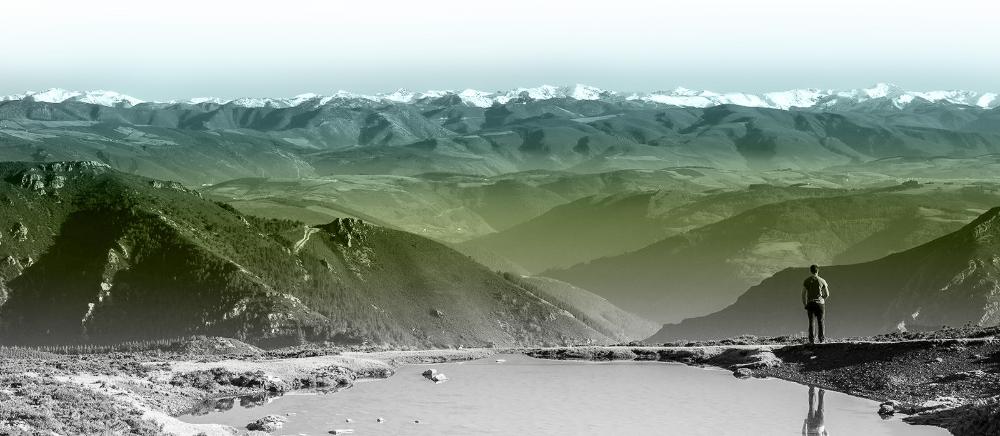
Subscribe to our newsletter and take advantage of offers, discounts, and news
Subscribe

